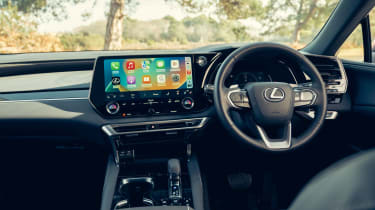New Lexus RX 450h+ 2023 review
Lexus's large SUV offers plenty of luxury and tech, but it's not as family-friendly as its size would suggest
Verdict
The new Lexus RX 450h+ delivers on plenty of traditional Lexus attributes. There’s an impressive array of technology on board, the ride is tuned for comfort above all else and the build quality is exemplary. It’s a big SUV so fairly average practicality might be its undoing for some families and keen drivers will be better served elsewhere.
The Lexus RX was one of the first to secure a slice of the burgeoning luxury SUV sector when it launched in the late 1990s and the model line has gone on to reach 3.5million sales globally, helped by its pioneering hybrid technology.
Within the Lexus stable, the RX has been arguably the most successful car at taking on the established players from Germany. The incorporation of a self-charging hybrid powertrain in 2005 was a defining moment for the RX, but since then it’s taken evolutionary steps with a clear focus maintained on comfort and build quality. With this fifth-generation RX, however, Lexus claims it has made “a complete reinvention of the large luxury SUV” and produced a large premium SUV that is more competitive than ever.
The new RX has arrived just at the right time. 2023 has seen both the Mercedes GLE and BMW X5 receive mid-life updates, with hybridisation being added across the range for both models. As an early adopter of hybrid power, it’s no surprise every Lexus RX is electrified.
More reviews
The entry-level 350h comes with a 247bhp 2.5-litre four-cylinder petrol with self-charging hybrid technology and there’s also a 500h “performance hybrid” with 366bhp from its turbocharged 2.4-litre and plug-in hybrid system - the first time Lexus has mated turbocharging with hybrid power.
In the middle of the pack sits the 450h+, which borrows its 2.5-litre four-cylinder petrol engine and plug-in hybrid system from the new NX - the first Lexus to offer PHEV capability. The new all-electric RZ (Lexus’s first bespoke full-EV) might look similar to the RX, but that car will use the e-TNGA platform found under the Toyota bZ4X and Subaru Solterra. The RX actually sits on the same GA-K platform as the smaller NX.
Our first taste of the new RX comes in 450h+ form - which Lexus says will account for 55 per cent of sales for its large SUV. The petrol engine combines with a 18.1kWh battery and an electric motor to drive the front wheels but there’s a second electric motor on the rear axle delivering electric four-wheel drive in certain circumstances. On paper the 450h+ sounds potent enough with 304bhp allowing for a 6.5-second 0-62mph time.
It takes a little time to adapt to this powertrain and ensure you’re playing to its strengths. It uses an e-CVT gearbox so if you’re mashing the throttle for an overtake, the petrol engine’s revs will rise to a rather unrefined drone. Hard acceleration overall feels a little underwhelming in the 450h+ although the system is perfectly smooth in its power delivery. Strangely, there are gearshift paddles behind the wheel which display the CVT’s ‘gears’. Given that there’s only one variable gear available in a CVT, moving up and down the simulated steps yourself doesn’t really have much of an effect on the driving experience. You just alter the level of engine braking slightly by raising or lowering the revs, we expect 99 per cent of RX owners won’t ever use the paddles.
Provided you have enough energy in the battery, you can, of course, switch to electric only mode. The instantaneous torque gives the RX some extra pep around town and silent EV running certainly suits the RX’s calm persona. Lexus claims around 40 miles of electric-only running is possible - most people should get near to this figure with careful driving.
Once that 18.1kWh battery has been emptied (the 6.6kW on-board charger means a full charge takes around two hours and 45 minutes), there’s a second battery that allows the 450h+ to run as a self-charging hybrid. This essentially means you’re always utilising the efficiency benefits of hybrid running. It’s the first time we’ve come across this technology and for PHEV users that might forget to charge or find it impractical to do so regularly, it’s a nice safety net to have. Even with this innovation, the claimed 256.8mpg WLTP fuel economy figure will probably be out of reach for normal driving.
The powertrain rewards relaxed driving and this statement applies to the suspension too. Our car was fitted with adaptive damping, which doesn’t vary too much depending on your chosen setting. Even with 21-inch alloy wheels, it's plainly obvious the RX has been engineered to float over bumps and dips, rather than communicate the road surface to the driver.
We’re keen to try out the ‘Direct4’ four-wheel drive system exclusively offered on the RX 500h, which apparently keeps pitching under acceleration and braking at bay - that rocking motion was especially prevalent on this 450h+.
Arrive at a series of bends and despite the focus on comfort, the RX can get into a rhythm. The steering wheel has a reassuring weight to it and the handling is tightened by the availability of six degrees of rear-axle steering. You’re always aware of the 2,240kg kerb weight but you can still flow the RX into corners nicely. Get a little too abrupt with steering inputs and you’ll a tendency towards safe, nose-heavy understeer.
Lexus says it has worked hard on improving the RX’s refinement, although the previous model was one of the best in its class in this respect. The powertrain certainly helps, but thicker glass and more sound proofing means this model is supremely quiet even at motorway speeds.
The interior compliments the sedate nature of the RX very well. We tested the top-spec Takumi trim level, which has a huge electric panoramic roof, heated seats front and rear, three-zone climate control and an uprated sound system.
The 14-inch central screen is the main focal point up front and the infotainment system responds immediately to inputs, either from the touchscreen itself or from the steering wheel buttons. It marks a huge step forward from the old track pad setup from the previous Lexus RX and Apple CarPlay or Android Auto can be wirelessly connected as well.
A Mercedes GLE might have the RX beaten in terms of interior wow factor, but the Lexus is up there with the very best for build quality. All the main touchpoints feel solid and things like the door handles and centre console openings are superbly damped. The rear seats can be folded up and down with the touch of a button - parents might prefer the quicker manual lever on lower-spec models.
There are lots of little cubby holes dotted around the cabin and the rear seats will accommodate three adults with no problem, but the lack of a seven-seat model is a bit of a shame. The 461-litre boot is also a little disappointing compared to the competition.
A mid-range ‘Premium Plus Pack’ still offers the panoramic roof as well as a head-up display and wireless charger. It also has the adjustable digital rear view mirror/monitor, which is an impressive bit of kit but slightly superfluous considering rear visibility is perfectly acceptable.
The RX with this 450h+ powertrain kicks off at £64,950 in Premium Plus guise - rising to £79,450 for this Takumi model. Given the new 2023 X5 starts from £66,230 with a mild-hybrid engine and you can’t get a Mercedes GLE for under £77,890, the RX 450h+ appears to be keenly priced.
|
Model: |
Lexus RX 450h+ Tekna |
|
Price: |
£79,450 |
|
Powertrain: |
2.5-litre 4cyl petrol + 2x e-motors |
|
Power/torque: |
304bhp/N/A |
|
Transmission: |
e-CVT automatic, four-wheel drive |
|
0-62mph: |
6.5 seconds |
|
Top speed: |
124mph |
|
Economy/CO2: |
256.8mpg/24g/km |
|
On sale: |
Now |
Now read our list of the best plug-in hybrids...









